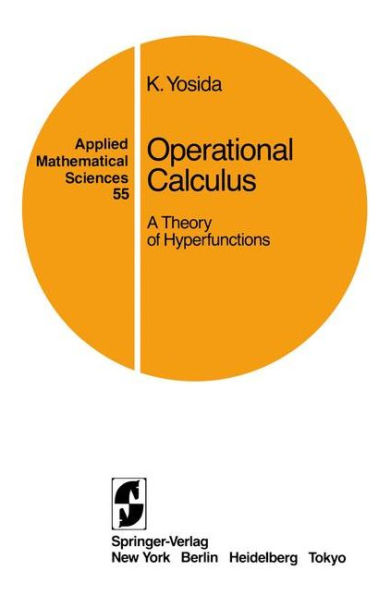Operational Calculus: A Theory of Hyperfunctions
In the end of the last century, Oliver Heaviside inaugurated an operational calculus in connection with his researches in electromagnetic theory. In his operational calculus, the operator of differentiation was denoted by the symbol "p". The explanation of this operator p as given by him was difficult to understand and to use, and the range of the valid ity of his calculus remains unclear still now, although it was widely noticed that his calculus gives correct results in general. In the 1930s, Gustav Doetsch and many other mathematicians began to strive for the mathematical foundation of Heaviside's operational calculus by virtue of the Laplace transform -pt e f(t)dt. ( However, the use of such integrals naturally confronts restrictions concerning the growth behavior of the numerical function f(t) as t ~ ~. At about the midcentury, Jan Mikusinski invented the theory of con volution quotients, based upon the Titchmarsh convolution theorem: If f(t) and get) are continuous functions defined on [O,~) such that the convolution f~ f(t-u)g(u)du =0, then either f(t) =0 or get) =0 must hold. The convolution quotients include the operator of differentiation "s" and related operators. Mikusinski's operational calculus gives a satisfactory basis of Heaviside's operational calculus; it can be applied successfully to linear ordinary differential equations with constant coefficients as well as to the telegraph equation which includes both the wave and heat equations with constant coefficients.
1113836691
Operational Calculus: A Theory of Hyperfunctions
In the end of the last century, Oliver Heaviside inaugurated an operational calculus in connection with his researches in electromagnetic theory. In his operational calculus, the operator of differentiation was denoted by the symbol "p". The explanation of this operator p as given by him was difficult to understand and to use, and the range of the valid ity of his calculus remains unclear still now, although it was widely noticed that his calculus gives correct results in general. In the 1930s, Gustav Doetsch and many other mathematicians began to strive for the mathematical foundation of Heaviside's operational calculus by virtue of the Laplace transform -pt e f(t)dt. ( However, the use of such integrals naturally confronts restrictions concerning the growth behavior of the numerical function f(t) as t ~ ~. At about the midcentury, Jan Mikusinski invented the theory of con volution quotients, based upon the Titchmarsh convolution theorem: If f(t) and get) are continuous functions defined on [O,~) such that the convolution f~ f(t-u)g(u)du =0, then either f(t) =0 or get) =0 must hold. The convolution quotients include the operator of differentiation "s" and related operators. Mikusinski's operational calculus gives a satisfactory basis of Heaviside's operational calculus; it can be applied successfully to linear ordinary differential equations with constant coefficients as well as to the telegraph equation which includes both the wave and heat equations with constant coefficients.
54.99
In Stock
5
1

Operational Calculus: A Theory of Hyperfunctions
170
Operational Calculus: A Theory of Hyperfunctions
170Paperback(Softcover reprint of the original 1st ed. 1984)
$54.99
54.99
In Stock

Product Details
| ISBN-13: | 9780387960470 |
|---|---|
| Publisher: | Springer New York |
| Publication date: | 07/30/1984 |
| Series: | Applied Mathematical Sciences , #55 |
| Edition description: | Softcover reprint of the original 1st ed. 1984 |
| Pages: | 170 |
| Product dimensions: | 6.10(w) x 9.25(h) x 0.02(d) |
From the B&N Reads Blog
